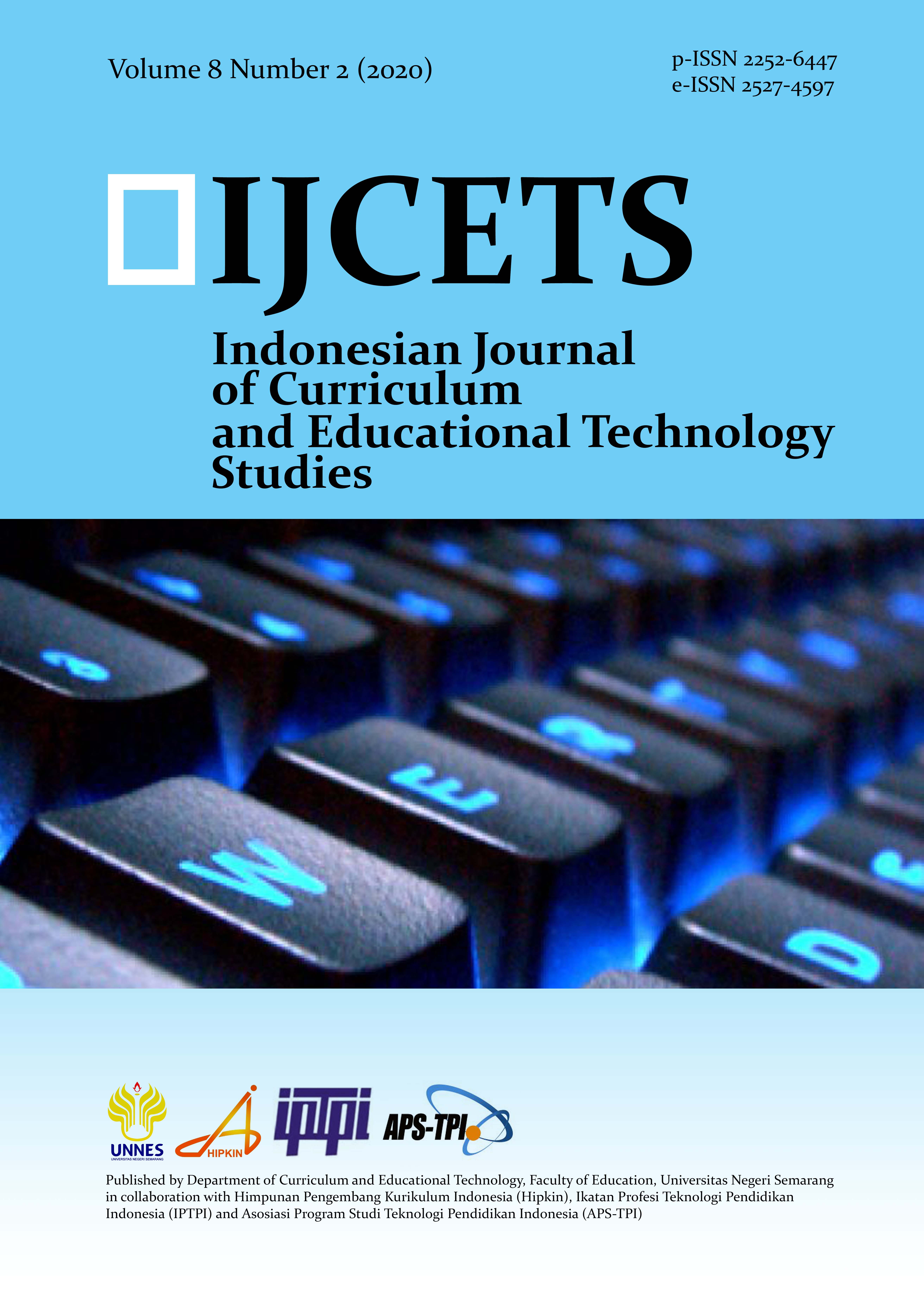Abstract
A discussion of the functions of curriculum theory appears to be mostly overlooked in the scholarly works that endeavor to develop models in certain curriculum areas. This essay article revisits the functions of curriculum theory as a foundational ground for the development of a procedural model to determine the null curriculum. I first discuss in this article the functions of curriculum theory such as description, explanation, prediction, and guidance. Then, specifically under the guidance function, I trace the task of model development in Curriculum Studies. Finally, I relate towards the end of this article the current need to develop a procedural model to determine the null curriculum.
Abstrak
Diskusi mengenai fungsi teori kurikulum tampak lebih banyak diperhatikan di dalam dunia akademik yang berupaya mengembangkan model-model dalam bidang-bidang kurikulum tertentu. Artikel ini bertujuan untuk meninjau kembali fungsi dari teori kurikulum sebagai dasar yang sifatnya fondasional dalam pengembangan model prosedural untuk memastikan rumusan Null Curriculum. Pertama saya mendiskusikan mengenai fungsi teori kurikulum, misalnya fungsi mendeskripsikan, menjelaskan, memprediksi, dan membimbing. Kemudian secara lebih spesifik mengacu pada fungsi pembimbingan dari kurikulum saya menelusuri tugas model pengembangan dalam Kajian Kurikulum. Terakhir, saya mengaitkannya dengan kebutuhan untuk mengembangkan model prosedural untuk memantapkan rumusan Null Curriculum.
References
Apple, M. W. (1990). Ideology and curriculum. London: Routledge. https://doi.org/10.4324/9780203241219
Beauchamp, G. A. (1961). Curriculum theory. Illinois: Kagg Press. https://doi.org/10.2307/1179213
Beauchamp, G. A. (1972). Basic components of a curriculum theory. Curriculum Theory Network, 10(1), 16-22. https://doi.org/10.2307/1179213
Beauchamp, G. A. (1981). Curriculum theory: Meaning, development and use. Theory into Practice, 21(1), 23-27. https://doi.org/10.1080/00405848209542976
Eisner, E. W. (1979). The educational imagination: On the design and evaluation of school programs. New York: Macmillan.
Flinders, J., Noddings, N., & Thornton, S. (1986). The null curriculum: Its theoretical basis and practical implications. Curriculum Inquiry, 16(1), 33-42. https://doi.org/10.2307/1179551
Freire, P. (1974) Education: The practice of freedom. London: Writers Readers.
Giroux, H. A. (1983). Theory and resistance in education: A pedagogy of the opposition. South Hadley, MA: Bergin and Garvey.
Joubert, L. (2008). Educating in the arts: The Asian experience: Twenty-four essays. Dordrecht, Netherlands: Springer.
Keat, R., & Urry, J. (1975). Social theory as science. London: Routledge & Kegan Paul.
Kian, M. (2016). Analysis the null curriculum of nutritional literacy among high school students. Journal of Theory & Practice in Curriculum, 6(3), 101-120. https://doi.org/10.18869/acadpub.cstp.3.6.101
Kridel, C. (2010). Encyclopedia of Curriculum Studies. Thousand Oaks, CA: SAGE. https://doi.org/10.4135/9781412958806
Lee, B. (2006). Teaching justice and living peace: Body, sexuality, and religious education in Asian American communities. Religious Education, 101(3), 402. https://doi.org/10.1080/00344080600788514
Moore, A. (2014). Understanding the school curriculum: Theory, politics and principles. New York: Routledge. https://doi.org/10.4324/9780203297595
Pinar, W. F. (1979). Curriculum theorizing: The reconceptualists. Berkeley: McCutchan. https://doi.org/10.4324/9781315786698-24
Quinn, M., & Christodoulou, N. (2019). Making Manifestos in Absentia: Of a World Without Curriculum Theory. In Internationalizing Curriculum Studies (pp. 35–51). Springer International Publishing. ttps://doi.org/10.1007/978-3-030-01352-3_3
Schubert, W. H. (1986). Curriculum: Perspective, paradigm, and possibility. New York: Macmillan. https://doi.org/10.1177/002248718703800113
Steiner, E. (1972). Conceptual structures for curriculum inquiry. Paper presented at the American Educational Research Association Meeting, Chicago, Illinois, April 7, 1972.
Taba, H. (1962). Curriculum development: Theory and practice. New York: Harcourt Brace Jovanovich.
Tyler, R. W. (1949). Basic principles of curriculum and instruction. Chicago: University of Chicago Press. https://doi.org/10.7208/chicago/9780226820323.001.0001
Vallance, E. (1982) The practical uses of curriculum theory. Theory into Practice, 21(1), 4-10. http://dx.doi.org/10.1080/00405848209542973
Wakeland, R. (2010). Visual and plastic arts in teaching literacy: null curricula? Retrieved from https://eric.ed.gov/?id=ED509073
Walker, D. F. (1982) Curriculum theory is many things to many people. Theory into Practice, 21(1), 62-65. https://doi.org/10.1080/00405848209542983
Watson, S., Miller, T. L., Driver, J., Rutledge, V., McAllister, D. (2005). English language learner representation in teacher education textbooks. Education, 126(1) 148-157. Retrieved from http://web.b.ebscohost.com/ehost/
Zimmerman, E. D. (1982). Digraph analysis and reconstruction of Broudy’s aesthetic education theory: an exemplar for aesthetic education theory analysis and construction. Studies in Art Education, 23(3), 39-47. https://doi.org/10.2307/1320015
